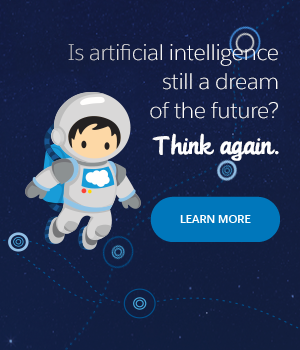
Get your FREE 30-day trial.
Please complete all fields.
For most of the people reading this post, artificial intelligence seemed like a far-off futuristic thing. Unless you’re a computer scientist or engineer, the term AI likely conjures up images straight out of science fiction: robots roaming the earth and machines that cook breakfast like the Jetson’s foodarackacycle.
But AI isn’t just a sci-fi dream of the future from our childhoods anymore — it’s here and already a core part of the apps, tools, gadgets, and services we use every day. It’s all around us already, but not in a creepy way. Most of the time we don’t even realize it’s there, and yet, AI has made our lives much easier. In fact, check out these amazing stats that reminds us that AI technology is here to stay.
That’s a big prediction Gartner made in 2011. I don’t know where we stand in terms of current percentages, but as of 2017, the statistic doesn’t seem so far-fetched. We know that chatbot usage is on the brink of explosion, and that products with digital personal assistants like Alexa and Siri are similarly on the rise. How much so? See #2.
 2. 57 percent of consumers expect voice-activated smart assistants to have a major or moderate impact on their daily lives by 2020.
2. 57 percent of consumers expect voice-activated smart assistants to have a major or moderate impact on their daily lives by 2020.First, there were smartphone personal assistants like Siri, Cortana and Google Assistant. Then came Alexa, backed by Amazon’s arsenal of products and services. Now, with the arrival of the Amazon Echo Dot in 2016, powerful AI-technology was suddenly at a price point available to millions of individuals. GAME CHANGER. More products will incorporate talking assistants in their design. As AI technology getting smarter, and people get more comfortable interacting with them, all signs point towards increased adoption according to the State of the Connected Customer.
Machine learning. Natural language processing. It was only a matter of time before innovative AI technologies would have the ability to proactively assemble information through automatic composition engines; a.k.a. machine-generated content. Gartner predicts that data-based and analytical information can be turned into natural language writing using emerging tools. Business content like shareholder reports, legal documents and press releases are all candidates for automated writing tools.
We keep hearing about how the Internet of Things is full of devices, wearables, and machines all connected together and how companies need to anticipate IoTs impact on our lives. Well here’s something we might not have fully anticipated: all of those ‘things’ are going to need support. Gartner reveals that enterprises will need to begin viewing things as customers, and respond to them accordingly. Strategies need to be developed for responding to machines that are very different from traditional human-customer interactions; we’re talking a new kind of service industry!
The connected car market has arrived and its takeover will be swift. According to Statista, the share of new cars connected to the Internet was 35 percent in 2015, but is expected to rise to 98 percent by 2020. Smarter, connected cars also means more apps to enhance the driving experiences: navigational services, information, and entertainment to name a few. That’s where voice-activated AI really takes centerstage to keep drivers focused on the road instead of pressing buttons or programming screens. And with driverless cars looming on the horizon, you’ll be requesting your car to drive you home or to the grocery store in the not so distant future as well.
In recent years enterprises are leveraging artificial intelligence to help analyze data and make better business decisions — and it seems that business leaders are feeling positive about the technology. A survey from Narrative Science reveals that CEOs, analysts, data scientists and knowledge workers don’t believe that AI is killing jobs. Quite the opposite: on average companies feel that they are only getting 53 percent of the potential insight from their available data, so they’ll need more workers with analytical expertise, as well as managers with the skills necessary to understand and make decisions based on big data analysis.
